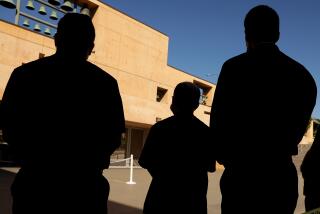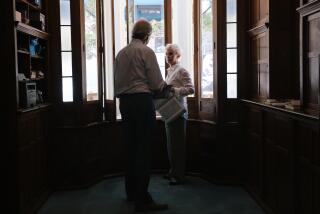Minister Converts Hostility to Prosperity : Blake Turned Fortunes Around, and West Angeles Was the Winner
- Share via
When his bishop first introduced the Rev. Charles E. Blake, then 28, to his present congregation in Los Angeles, he faced hostility in the pews.
The time was 1969, and the small West Angeles Church of God in Christ was engaged in a conflict with Bishop S. M. Crouch. Though the church pulpit was vacant after the death of its founding pastor, members had voted by a 4-1 margin to refuse any pastor appointed by Crouch.
After the young preacher was introduced, seven men stood in protest and refused to sit, so the bishop had everyone rise. Then the bishop tapped Blake on the shoulder, said, “It’s yours, my boy,” and walked out of the church.
“I always wondered why I didn’t leave too,” Blake recalled this week.
Won Vote of Confidence
But he said he starting talking and eventually got a vote of confidence from most of the people present. Internal battles in the congregation, numbering about 50, finally subsided over the next two or three years, Blake said.
After that unpromising start, the church has grown to 2,373 adult members, with 1,876 more seeking membership. It may be the biggest church in the largest black Pentecostal denomination in the country.
“I don’t know of another church that is larger,” Blake said. The Church of God in Christ, based in Memphis, Tenn., claims more than 3 million members.
In 1985, Blake was appointed a bishop himself. In that role, he will convene his Southern California jurisdiction’s annual seven-day convocation starting Monday at the Shrine Auditorium.
The denomination’s congregations may affiliate with any of five bishops in Southern California, regardless of location. With 225 affiliated churches, Blake’s jurisdiction is the largest of the five.
It is obvious from an interview, however, that Blake’s pride is not in denominational stature but in the church he still pastors and its impact on a once run-down part of Crenshaw Boulevard.
Community Use
Located a few blocks south of the Santa Monica Freeway, West Angeles Church of God in Christ has transformed old commercial sites into a church-and-school complex to be enhanced in coming months with a small banquet facility and Christian theater--for use by the community as well as by the church.
In 1976, the congregation had outgrown its facility on West Adams Boulevard (the church where the young Blake faced unfriendly parishioners). It bought and remodeled an old furniture store on Crenshaw Boulevard for $1.5 million, turning it into a carpeted and cushioned sanctuary that seats nearly 1,300 worshipers.
But for at least two years, chairs have been placed in the aisles for the two Sunday morning services to accommodate the burgeoning attendance. Blake said he hopes to add a third morning service by August when a large Sunday School class that meets there in mid-morning can move into new classrooms.
The church, which has a $2.3-million annual budget, plans to show Christian movies and stage inspirational productions at a theater it recently purchased across the street.
Gene Shelton, a member who serves as publicist for the church, said the average age of members appears to be between 35 and 45 years and includes many professionals and some entertainment figures. That is seen as a significant change for a Pentecostal denomination.
Personifies Changes
“The Church of God in Christ was once considered too ‘holy roller’ to attract the educated and middle-class black,” said Shelton, who runs his own marketing and public relations firm.
Blake, who will turn 47 in August, appears to personify the changes occurring in the denomination. Tall, lean and admittedly interested in good management procedures, he is thoughtful and straight-forward in his answers.
He earned a bachelor’s degree from California Western University (now United States International University) in San Diego in 1962 and then got a Master of Divinity degree from the Interdenominational Theological Center in Atlanta in 1965.
“I was student body president during the Selma and Montgomery, Ala., demonstrations,” Blake said. Despite being raised in the traditionally apolitical Pentecostal tradition, Blake said he could not help but be an activist then.
“Something of that, I suppose, is still a part of me,” Blake said. He added his name early this year to a statement, circulated by Los Angeles ecumenical church leaders, that was critical of U.S. foreign policy in South Africa and Nicaragua.
“I do not hesitate to mention a social issue in a sermon if I feel that the teachings of the Bible can be applied.” He added, however, that “as I grow older, I am much less inclined to endorse individual political candidates,” a common practice in black Protestant churches.
At the same time, in tune with the decade-old resurgence of theologically conservative churches, Blake’s preaching reflects “a high view,” he said, of the Bible’s historical reliability and authority for moral guidance.
Responds to ‘Yearning’
Though teaching a conservative personal life style, Pentecostal churches respond to a “yearning” of people today, he contended. “Worship services allow the individual to express his feelings and give adoration to God,” he said.
Speaking in tongues, spiritual healing and other claimed manifestations of the Holy Spirit are encouraged--within understood bounds. “I believe it is possible to be intelligent and dignified, and still be expressive,” he said.
A number of large, growing black churches in Los Angeles are also Pentecostal in beliefs, notably Crenshaw Christian Center, the 15,000-member, nondenominational church pastored by the Rev. Frederick Price.
While unwilling to make an extensive comparison of his approach to that of Price, whom Blake termed a “personal friend,” Blake said he does not emphasize teachings that seem to promise prosperity to those who have sufficient faith. “Our members should not expect never to get sick or have problems,” Blake said.
Like Price’s church, West Angeles church is highly organized.
“Every person who comes gets a letter, a different one after each visit,” Blake said. More than 400 people are currently going through a 13-week membership class or are in the applicant stage.
Though West Angeles church reported about 2,200 full members in early 1985--about the same as the present number--Blake said, “We had an aggressive roll-cleaning (campaign) in 1985 and 1986.” Even now, he said, 571 people who appear to be inactive or have moved are not being counted as members.
Once they are full members, they continue to get frequent letters and “telephone captains” seek to keep people involved. “The larger you get, the more you have to emphasize that,” Blake said.
More to Read
Sign up for Essential California
The most important California stories and recommendations in your inbox every morning.
You may occasionally receive promotional content from the Los Angeles Times.










